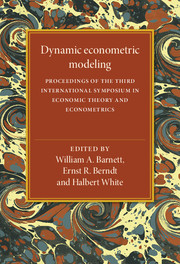 Dynamic Econometric Modeling
Dynamic Econometric Modeling Book contents
- Frontmatter
- Contents
- Editors' introduction
- List of contributors
- Part I Dynamic structural modeling
- 1 Efficient instrumental variables estimation of systems of implicit heterogeneous nonlinear dynamic equations with nonspherical errors
- 2 Envelope consistent functional separability
- 3 Flexible functional forms for profit functions and global curvature conditions
- 4 Likelihood inference in the nonlinear regression model with explosive linear dynamics
- 5 Exact inference in models with autoregressive conditional heteroscedasticity
- 6 Control of a linear regression process with unknown parameters
- 7 Some tests of nonparametric regression models
- Part II Linear time series modeling
- Part III Chaotic attractor modeling
- Part IV Applications
6 - Control of a linear regression process with unknown parameters
Published online by Cambridge University Press: 03 May 2010
- Frontmatter
- Contents
- Editors' introduction
- List of contributors
- Part I Dynamic structural modeling
- 1 Efficient instrumental variables estimation of systems of implicit heterogeneous nonlinear dynamic equations with nonspherical errors
- 2 Envelope consistent functional separability
- 3 Flexible functional forms for profit functions and global curvature conditions
- 4 Likelihood inference in the nonlinear regression model with explosive linear dynamics
- 5 Exact inference in models with autoregressive conditional heteroscedasticity
- 6 Control of a linear regression process with unknown parameters
- 7 Some tests of nonparametric regression models
- Part II Linear time series modeling
- Part III Chaotic attractor modeling
- Part IV Applications
Summary
Introduction
Applications of forms of control theory to economic policy making have been studied by Theil (1958), Chow (1975, 1981), and Prescott (1972). Many of the applications are approximations to the optimal policy – suggestions of how to improve existing practice using quantitative methods rather than development of fully optimal policies. Chow (1975) obtains the fully optimal feedback control policy for linear systems with known coefficients for a quadratic loss function and a finite time horizon. Chow (1981) argues that the use of control technique for the evaluation of economic policies is possible and essential under rational expectations. The use of optimal control for microeconomic planning is fully established. An early analysis with many practical suggestions is Theil (1958). Optimal control theory has also been useful in economic theory, in analyzing the growth of economies as well as the behavior over time of economic agents.
The problem of control of a stochastic economic system with unknown parameters is far less well studied. Zellner (1971, Chapter 11) studied the two–period control problem for a normal regression process with a conjugate prior and quadratic loss function.
Information
- Type
- Chapter
- Information
- Dynamic Econometric ModelingProceedings of the Third International Symposium in Economic Theory and Econometrics, pp. 105 - 120Publisher: Cambridge University PressPrint publication year: 1988
Accessibility standard: Unknown
Why this information is here
This section outlines the accessibility features of this content - including support for screen readers, full keyboard navigation and high-contrast display options. This may not be relevant for you.Accessibility Information
- 1
- Cited by